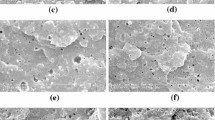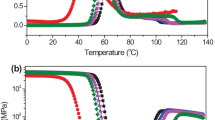Abstract
PVC and SAN are often mixed to compensate for the disadvantages of each polymer. Miscibility and thermal stability of PVC/SAN blend were investigated in this study by blending SAN polymer having 20, 24, 28, 32 % of acrylonitrile contents. Two polymers were mixed using a melt blending method with a single screw extruder. DSC them ogram was used to evaluate miscibility of the two polymers. SAN having 24 % of acrylonitrile showed the best miscibility with PVC. In order to evaluate degradation behavior, blended polymer was heat treated in DSC furnace and glass transition temperature was measured consecutively. Glass transition temperature increased continuously with annealing time due to degradation and cross-linking of polymer chains. Melt index of blended polymer was always higher than that of PVC.
Similar content being viewed by others
References
W. A. Pavelich in “High Performance Polymers: Their Origin and Development”, (R. B. Seymour and G.S. Kirshenbaum Eds.), p.125, Elsevier, New York, 1986.
R. Buchadhl and L. E. Nieken,J. Polym. Sci.,15, 1 (1955).
I. A. Schneider and E. M. Calugaru,Eur. Polym. J.,12, 879 (1976).
R. D. Deanin and C. Moshar,Polym. Prepr. Am. Chem. Soc.,15, 403 (1974).
H. Breuer, F. Haaf, and J. StabenowJ. Macromol. Sci. Phys.,B14, 387 (1997).
A. Pavan, T. Ricco, and M. Rink,Mater. Sci. Eng.,48, 9 (1981).
W. L. Congdon, H. E. Bair, and S. K. Khanna in “Polymer Alloys”, (D. Klempner and K. C. Frisch Eds.), p.256, Plenum, New York, 1980.
J. H. Kim, J. W. Barlow, and D. R. Paul,J. Polym. Phys.: Part B: Polym. Phys.,27, 2211 (1989).
J. K. Park, T. S. Hwang, K. S. Maeng, C. H. Kim, and C. D. Park,Polymer (Korea),15, 251 (1991).
M. Rink, L. Monfrint, P. Gasparini, and A. Pavan,Plastic Rubber Processing Applications,3, 145 (1983).
P. P. GAn, D. R. Padwa,Polymer,35, 1487 (1994).
S. Zerafati,J. Vinyl Additive Technology,4, 35 (1998).
D. Braun and S. Kömmerling,Die Angewandte Makromolekulare Chemie,195, 205 (1992).
D. W. Jin, K. H. Shon, B. K. Kim, and H. M. Jeong,J. Appl. Polym. Sci.,70, 705 (1998).
Author information
Authors and Affiliations
Corresponding author
Rights and permissions
About this article
Cite this article
Wang, L., Kim, H.C., Pak, P.K. et al. Effect of acrylonitrile content on the glass transition temperature and melt index of PVC/SAN blends. Fiber Polym 7, 36–41 (2006). https://doi.org/10.1007/BF02933600
Received:
Revised:
Accepted:
Issue Date:
DOI: https://doi.org/10.1007/BF02933600




